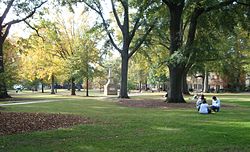Presidents of the University of South Carolina
| No. | Image | Name | Tenure | Notes |
|---|---|---|---|---|
| 1 |  | Jonathan Maxcy | 1804–1820 | |
| 2 |  | Thomas Cooper | 1821–1834 | |
| – | Robert Henry | 1834 | President pro tempore | |
| – | Henry Junius Nott | 1834–1835 | Chairman of the Faculty | |
| 3 |  | Robert Woodward Barnwell | 1835–1841 | |
| 4 | Robert Henry | 1841–1845 | ||
| 5 |  | William C. Preston | 1845–1851 | |
| – |  | Francis Lieber | 1851 | President pro tempore |
| 6 |  | James H. Thornwell | 1851–1855 | |
| 7 | Charles F. McCay | 1855–1857 | ||
| 8 |  | Augustus B. Longstreet | 1857–1861 | |
| – | Maximilian LaBorde | 1861–1865 | Chairman of the Faculty | |
| – |  | Robert Woodward Barnwell | 1865–1873 | Chairman of the Faculty |
| – | Benjamin B. Babbitt | 1873–1875 | Chairman of the Faculty | |
| – | Anson W. Cummings | 1875–1877 | Chairman of the Faculty | |
| 9 |  | William Porcher Miles | 1880–1882 | |
| 10 |  | John McLaren McBryde | 1883–1891 | |
| 11 |  | James Woodrow | 1891–1897 | |
| 12 | Frank C. Woodward | 1897–1902 | ||
| 13 | Benjamin Sloan | 1902–1908 | Acting President from 1902 to 1903 | |
| – | Andrew C. Moore | 1908–1909 | Acting President | |
| 14 |  | Samuel Chiles Mitchell | 1909–1913 | |
| – | Andrew C. Moore | 1913–1914 | Acting President | |
| 15 |  | William Spenser Currell | 1914–1922 | |
| 16 | William Davis Melton | 1922–1926 | ||
| – | Leonard T. Baker | 1926 | Acting President | |
| 17 | Davison McDowell Douglas | 1927–1931 | ||
| 18 | Leonard T. Baker | 1931–1936 | ||
| 19 | James Rion McKissick | 1936–1944 | ||
| – | Leonard T. Baker | 1944–1945 | Acting President | |
| 20 | Norman Murray Smith | 1945–1952 | ||
| – | Francis Wright Bradley | 1952 | Acting President | |
| 21 |  | Donald S. Russell | 1952–1957 | |
| 22 | Robert Llewellyn Sumwalt | 1957–1962 | Acting President from 1957 to 1959 | |
| 23 | Thomas F. Jones | 1962–1974 | ||
| 24 | William H. Patterson | 1974–1977 | ||
| 25 | | James B. Holderman | 1977–1990 | |
| – |  | Arthur K. Smith | 1990–1991 | Interim President |
| 26 |  | John M. Palms | 1991–2002 | |
| 27 | Andrew A. Sorensen | 2002–2008 | ||
| 28 |  | Harris Pastides | 2008–2019 | |
| 29 |  | Robert L. Caslen | 2019–2021 | |
| – |  | Harris Pastides | 2021–2022 | Interim President; 2nd time |
| 30 |  | Michael Amiridis | July 1, 2022 | Incumbent |
